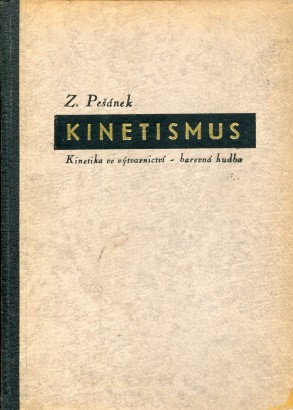Zdeněk Pešánek: Kinetismus: Kinetika ve výtvarnictví – barevná hudba (1941) [Czech]
Filed under book | Tags: · abstract cinema, art, avant-garde, film, kinetic art, light, light art, sound, visual music

Zdeněk Pešánek (1896-1965) was one of the most inventive and original Czech sculptors of the 20th century, who pioneered experiments in light- and kinetic sculptures. His works, highly abstract and biomorphic, made use of neon and incandescent lighting as part of the sculptural elements. He also was a designer for both architectural and interior structures, and worked with the fusion of light and music, developing the use of “clavieres a lumieres” and light-organs. His aesthetic was more informed by sound and tonality than visual precedent, and is quite original. At this date almost no sculptures exist in private hands and the public sculptures have been largely damaged or destroyed. The book Kineticism: Kinetics in Fine Arts – Color Music is the only publication in his lifetime in which his theories were given exposition and is his creative credo as well, replete with b/w and color illustrations. Amazingly published during the Nazi occupation.
Edited by Josef Vydra
Publisher: Česká grafická unie, Prague, October 1941
Edice výtvarné výchovy, svazek 8
144 pages
PDF (no OCR, updated on 2013-2-12)
Comments (3)Stephen C. Foster (ed.): Hans Richter. Activism, Modernism, and the Avant-Garde (1998)
Filed under book | Tags: · abstract cinema, activism, art, art history, avant-garde, cinema

Few artists spanned the movements of early twentieth-century art as completely as did Hans Richter. Richter was a major force in the developments of expressionism, Dada, De Stijl, constructivism, and Surrealism, and the creator, with Viking Eggeling, of the abstract cinema. Along with Theo van Doesburg, László Moholy-Nagy, El Lissitzky, and a few others, he is one of the artists crucial to an understanding of the role of the arts in the reconstruction era following World War I.
Most American scholars have focused on Richter’s film work and have favored a strictly formalist approach that separates art and politics. The contributors to this book rewrite Richter’s history to include his pivotal role in the development of the early twentieth-century avant-garde and his political activism. When Richter’s work, particularly that of his earlier, European career, is viewed in its historical and political context, he emerges as an artist committed to the power of art to change the fabric of social, political, and cultural affairs.
Publisher The MIT Press, 1998
in collaboration with the University of Iowa Museum of Art, Iowa City
ISBN: 0262561298, 9780262561297
PDF (updated on 2012-7-31)
Comment (0)
